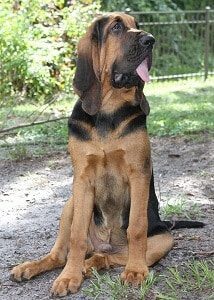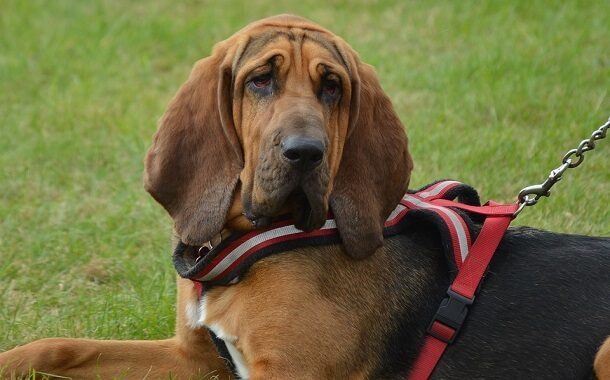Bloodhound Dog Cost
Last Updated on September 13, 2023
Written by CPA Alec Pow | Content Reviewed by ![]() CFA Alexander Popinker
CFA Alexander Popinker
Bloodhounds are a true paradox. With sunken eyes, furrowed face, and loose jowls they resemble a sad pet in dire need of a facelift – but this sad appearance is quite misleading. They have an adorable character with strong tendencies for humor balanced by their sensitive nature, even though they are pretty reserved around strangers.
The Bloodhound (also called the Saint-Hubert hound or “Flemish hound”) originated a long time ago in Belgium where hunters used these dogs primarily for tracking.
How much does a Bloodhound cost?
The Bloodhound price, as with all AKC dog breeds, will depend on the age of the puppy and its bloodline, among other factors. The average price ranges from $350 to over $1,000+ depending on where you purchase it from. For example: On PuppyFind they had close to 200 active listings for a variety of prices – ranging anywhere from less than $350 up to $1,000 or even more.
You might also like our articles about the cost of Norwegian Elkhounds, Pharaoh Hounds, or Basset Hounds.
On the other hand, the listings we found on the official AKC website ranged anywhere from $650 to $1,100.
What is going to be included in the adoption fee?
When you’re buying a puppy, it can be overwhelming to consider all the things that come with them. You want one healthy and happy pup after all. A reputable seller will do their best for your new furry friend by including some of these items in the deal: AKC registration paperwork; up-to-date vaccinations with proof; veterinarian exam & health certificate/guarantee from the vet; pedigree papers if applicable; microchip when available (usually included). Recommended health tests like cardiac exams or elbow evaluations might not always be included though.
What are the extra costs?
The Bloodhound is a breed of dog that’s known for being stubborn when they’re younger. They need at least basic obedience classes to teach them the basics commands and housebreaking techniques, which will help prevent behavioral problems in their later years. The bloodhound’s coat is short, hard, and smooth to touch with no outstanding hairs – it usually has red fur or black-and-red coloring.
There used to be white Bloodhounds called “Talbot Hounds” but these disappeared during the Middle Ages.
As you consider the adoption process, be sure to factor in all of the costs that come with owning a dog. Even though it may seem like they are very low upfront cost investments, there will undoubtedly be recurring expenses as well! These can include startup supplies (such as food and toys) or vet visits for routine checkups or emergencies. The average monthly expense is around $50 per month but this number will differ.
Tips to remember
 The Bloodhound is a large breed of dog with floppy ears and droopy skin. Males typically weigh more than 115 pounds, but females are about 10 percent smaller at around 100 pounds on average. These dogs have been known to be strong for their size as well as intelligent. They will have a lifespan of around 12 years when kept in captivity and properly taken care of. Some owners take their dogs hunting, on hikes, or for regular walks around the block.
The Bloodhound is a large breed of dog with floppy ears and droopy skin. Males typically weigh more than 115 pounds, but females are about 10 percent smaller at around 100 pounds on average. These dogs have been known to be strong for their size as well as intelligent. They will have a lifespan of around 12 years when kept in captivity and properly taken care of. Some owners take their dogs hunting, on hikes, or for regular walks around the block.
The Bloodhound has been known to be a very loving and caring dog. They love attention from children or adults alike, and will not become aggressive around strangers as other dogs might do. When they are comfortable in their own home environment the hound can be affectionate with those that they know well.
The University of Illinois has created a guide to discuss the benefits and drawbacks when it comes to owning a Bloodhound. Generally, they are known for drooling often, not living as long compared to other breeds such as Labrador Retrievers or German Shepherds, becoming difficult if trained incorrectly, and being very curious about new smells; which can lead them into danger on their own accord.
The Bloodhound is a very healthy breed, but it has its quirks. This includes hip dysplasia and epilepsy as well as the more common health conditions like hypothyroidism, ectropion, entropion, epilepsy, fold dermatitis, gastric dilatation-volvulus, and elbow dysplasia.
Is there any way to save money?
If you’re looking for a furry friend and are considering buying from a breeder, think again. Purchasing animals leads to more breeding which creates an overpopulation of dogs & cats in the world. Adopting instead can help rescue groups who could really use that funding to take care of other abandoned animals. To find your next best friend, take a look at the directory on American Bloodhound Club’s official website.


Leave a Reply
Want to join the discussion?Feel free to contribute!